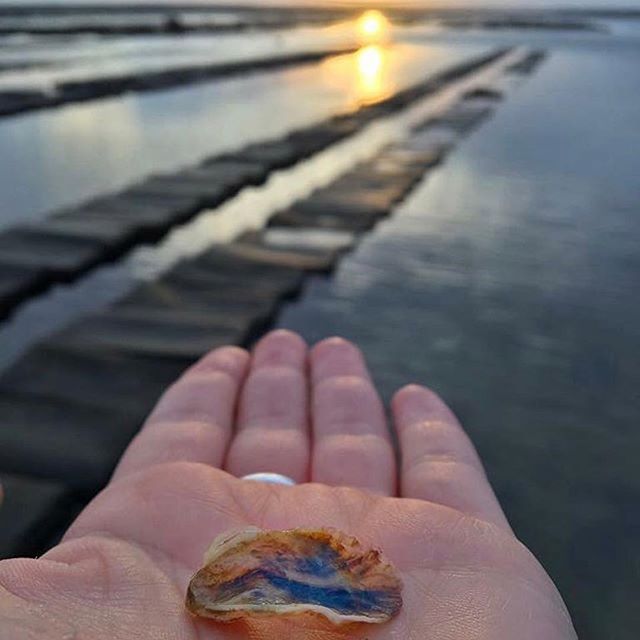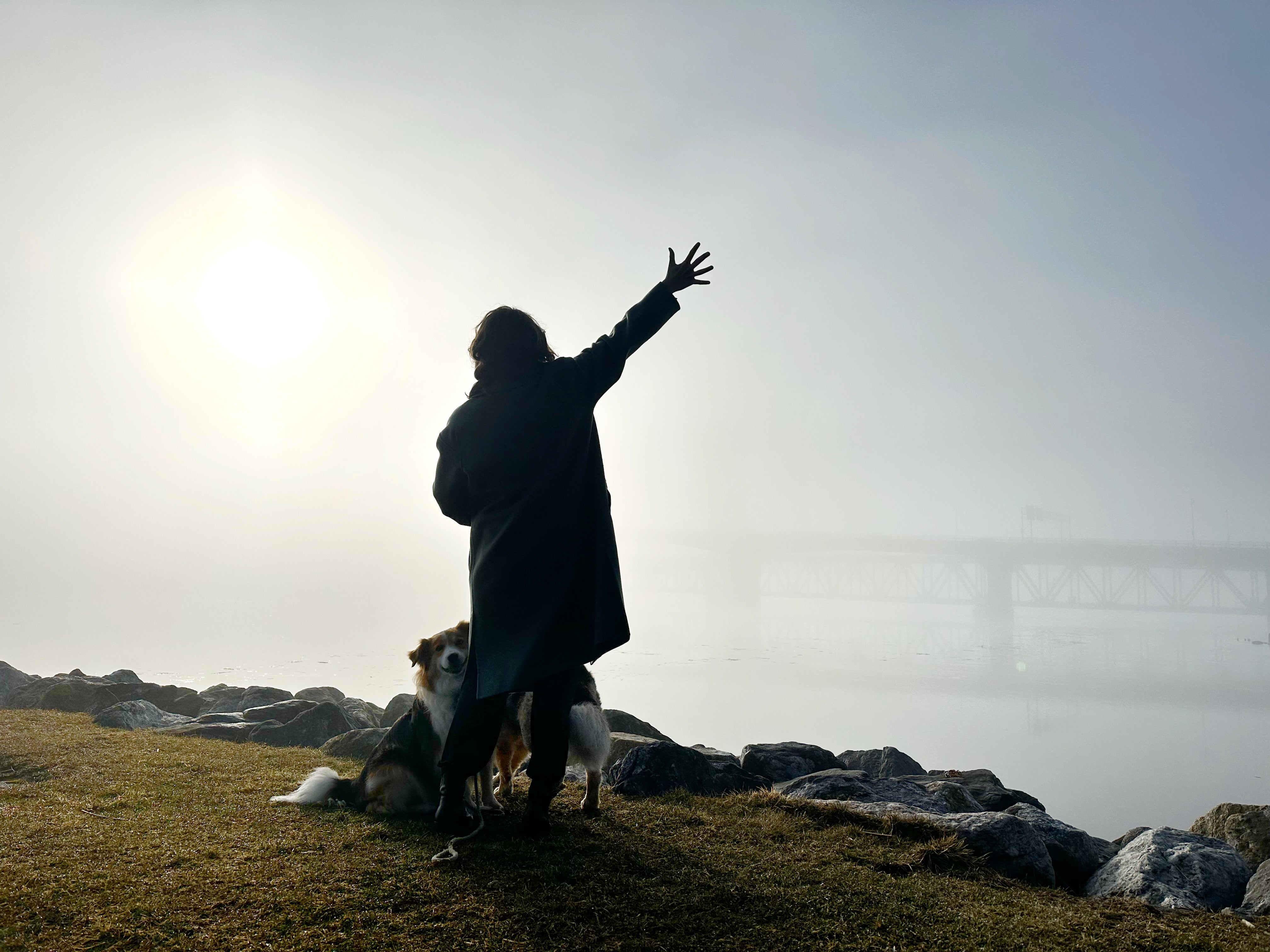"It's hard work, but the best kind of hard." | The Story of Moon Shoal Oysters

Jon hooked me on his story. There is something so refreshing about someone who, in the blink of an instant, knows what's next. For Jon, it was going from a full day at the Fire Station to a fulfilling one on an Oyster Farm. An unplanned boat ride changed the tides of life. Years later, you'll find Moon Shoal Oysters scattered all over New England and further beyond - coast-to-coast.
Let me introduce you to Jon Martin, a Cape native, who tried to leave paradise in search of another. But after living far and wide, the beauty of home stole his heart again (this trend sounds familiar, doesn't it? I swear there's something in the water on the Cape... literally).
Let him take you through the origins in his own words. Jon shares the best part of the job, the ecology of Barnstable Harbor, how to survive a bomb cyclone, and so much more. Thank you, Jon, for your passion, and the very delicious result we all get to enjoy!

Jon, I read on your “about” that you took a boat ride to an oyster farm and became a “changed man." I think I’m dying to know the full story of the day on your friend’s oyster farm and what convinced you it was your future?
Jon: I guess at the time, I wasn't really aware of why I was so into the idea of growing my own oysters; but from the beginning everything just felt right. I had stopped to talk to my daughter's friends' Dad (who I didn't know that well at all) on an ice cold morning 10 years ago or so, on the way home from a 24-hour shift at the Fire Station where I worked. Just 20 minutes later I was on his boat and we were heading out to his grant. I was kind of blown away. I knew that he was growing oysters, but I had never really given it a second thought... But as we slowly cruised along with the tide, snaking through the thatch islands and sandbars, and I saw what the farms looked like, what the gear looked like, and as he was explaining aquaculture to me, something clicked. Looking back, it was pretty serendipitous. I was looking for something to do own my own; and I was super into the idea that I could be part of something being grown, not made. I had always worked on parts of things - parts of a process. To be involved in the whole process of something - to grow something and not make something - and to be out on the water, it had me from the start.
What was life like growing up on the Cape?
Jon: Growing up on the Cape was awesome until I got a little older. I loved it as a kid but towards the end of high school, I felt like I was missing something. I moved away after high school and went to college; lived in Colorado, California and Eastern Europe... but all roads led back to the Cape. I totally took for granted how amazing and rare and beautiful of a place Cape Cod is. My wife is also from the Cape; and we both couldn't wait to get off Cape, until we couldn't wait to get back on the Cape, back to our roots. We feel so lucky to be able to raise our 3 daughters here. It's funny how the off season and the slow winter months are what I wanted to get away from, desperately, and now its my favorite time here.

Give us a day in the life?
Jon: A typical day on the farm depends on the time of year. We always have two classes growing (the seed and the oysters ready for market), and they both need tending to. We usually get seed mid-May from a few different hatcheries, and after they arrive, it is a daily process of washing and grading them, as they grow super fast in the Spring, Summer, and Fall. While the seed work is going on, we are also culling and grading and selling the oysters from the previous year. We grow all our seed in fine mesh bags and the grow-out of market-sized oysters is completed in trays placed on the bottom of our grant. That being said, the densities of the oysters in the different types of gear are essential to nicely shaped and cupped oysters. It's a lot of materials management; making sure the oysters are at the right density, in the right gear, at the right time. Our farm is only accessible at low tide by boat; so a typical day is based around the tide chart and weather. It's always so different. You have to love it. It's hard work, but the best kind of hard.

What do you feel is the most rewarding part about being an oyster farmer, and what is often the most challenging?
Jon: The most rewarding part of being an oyster farmer is knowing that there is really not a down side. Business is business, and some years are better than others, but even on our worst day, each adult oyster is filtering around 50 gallons of water per day. They are known as a "keystone species" because of the important ecological impact they have for both water quality and clarity, and they cycle nutrients between the water column and the bottom dwelling species. The fact that we can work in such a beautiful and pristine area of Barnstable Harbor in Cape Cod Bay, and have a positive impact, is something we don't take lightly. It truly is a win-win.
Sometimes the most challenging part of being an oyster farmer is how vulnerable you are to Mother Nature. Its farming after all; when it's good, it's good. But when it's bad, the wheels fall off and you are out countless hours of labor and a year away from a paycheck. Our inside joke is "the best thing about farming is next year." The crazy thing is that when things go bad, chances are you'll do the same thing next year with better results. It's tough to nail down an exact science. Through the years, you learn and you come up with systems that work, but at the end of the day, there's a lot that's out of your hands. I guess you just kind of do your best, and pray for a good year. Sometimes I think the hardest part is the worry. A late January night and it's 5 degrees out and it's a drainer tide and the wind is NE at 40? I can't sleep.
Let's talk about the product - ecology, methods, and what to expect.
Jon: Barnstable Harbor is an amazing place to grow oysters. The farm is only accessible by boat; it's about a 3 mile boat ride from our mooring. We have Sandy Neck to our north, which acts as our barrier beach. We have really big 10 foot tides, twice a day, everyday, so there is a big rush of crisp water coming right in from the Gulf of Maine. There are two fresh water creeks, which run over the farms from the West, and we are surrounded by thatch islands. All these attributes make up what we like to think is a somewhat complex taste. We're not chefs, but have been told by many that there is a lot going on in the flavor profile of a Moon Shoal. A nice balance of sweet and salt. We've heard "buttery" "creamy" "briny". Also heard that they're an east coast version of a west coast oyster. We think they're pretty awesome. Try some!
How did you cope with the recent "bomb cyclone"/arctic blast?!
Jon: Polar Vortex! What a crazy run of weather we just had. We try to stay one step ahead of arctic blasts in the winter. All of our gear, every last tray and bag comes out in early winter (and is returned early April). The only oysters left on the farm are consolidated into trays and put into the deepest part of the grant, where we can access them, depending on the weather. All of our seed is pulled in and placed in a walk-in cooler for a few months. The winter is usually spent repairing/building gear and selling oysters when the weather allows. And drinking coffee.

I know where to find a good Moon Shoal - I'm a townie after all :), but tell us your spots!
Jon: It always feels so good to see the awesome places our oysters end up. It used to be mainly Boston and New York, but we've been hearing about San Francisco and Nashville and other places as of late. Row 34 and Island Creek Oyster Bar in Boston are always so good. Get the smoked and cured plate at Row. It's nuts. Eventide in Portland, ME is awesome too. Stop in on the way home from the mountains, it's a perfect stop. That being said, we'd love to do more sales on Cape. We're working on it.

Any New Year's Resolutions in 2018?
Jon: 2018 farm goals would just be to keep growing the best oysters we can and enjoying ourselves and the process along the way. Maybe try to bump up the numbers a bit. Keep going with a little bit of gentle persistence. Catch a few more stripers this year.
What's the drink of choice with a Moon Shoal? Asking for a friend....
Jon: Best Pairing? I'd have to say after the tide, with an oyster right off the farm and cold beer on the boat. Can't beat it.
(Editor's note.... If only I had an oyster farm and a boat to pair with my beers...)
Do you love a good Moon Shoal oyster? Do you want to love one? Check out their website for more information, hit up some recommended spots from Jon, and follow them on Instagram at @moonshoaloysters!




